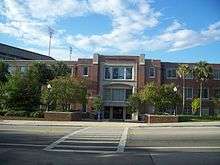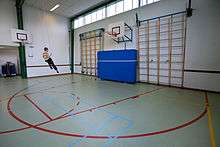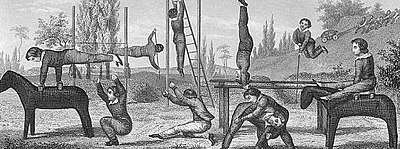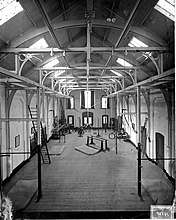Gym
A gymnasium, also known as a gym, is a covered location for athletics. The word is derived from the ancient Greek gymnasium.[1] They are commonly found in athletic and fitness centres, and as activity and learning spaces in educational institutions. "Gym" is also slang for "fitness centre", which is often an area for indoor recreation. A gym may be open air as well. A gym is a place with numer of equipments and machines used by the people to do exercises.
_Floor_Warm_Up_(5694074973).jpg)
Overview


Gymnasia apparatus such as barbells, jumping board, running path, tennis-balls, cricket field, and fencing area are used as exercises. In safe weather, outdoor locations are the most conducive to health.[2] Gyms were popular in ancient Greece. Their curricula included self-defense, gymnastica medica, or physical therapy to help the sick and injured, and for physical fitness and sports, from boxing to dancing to skipping rope.[3]
Gymnasia also had teachers of wisdom and philosophy. Community gymnastic events were done as part of the celebrations during various village festivals. In ancient Greece there was a phrase of contempt, "He can neither swim nor write." After a while, however, Olympic athletes began training in buildings specifically designed for them. Community sports never became as popular among ancient Romans as it had among the ancient Greeks. Gyms were used more as a preparation for military service or spectator sports. During the Roman Empire, the gymnastic art was forgotten. In the Dark Ages there were sword fighting tournaments and of chivalry; and after gunpowder was invented sword fighting began to be replaced by the sport of fencing, as well as schools of dagger fighting and wrestling and boxing.[4]
In the 18th century, Salzmann, German clergyman, opened a gym in Thuringia teaching bodily exercises, including running and swimming. Clias and Volker established gyms in London, and in 1825, Doctor Beck, a German immigrant, established the first gymnasium in the United States. It was found that gym pupils lose interest in doing the same exercises, partly because of age. Variety in exercises included skating, dancing, and swimming. Some gym activities can be done by 6 to 8-year-olds while age 16 has been considered mature enough for boxing and horseback riding.[5]
In Ancient Greece, the gymnasion (γυμνάσιον) was a locality for both physical and intellectual education of young men. The latter meaning of intellectual education persisted in Greek, German and other languages to denote a certain type of school providing secondary education, the gymnasium, whereas in English the meaning of physical education pertained in the word 'gym'.[6] The Greek word gymnasium, which means "school for naked exercise," was used to designate a locality for the education of young men, including physical education (gymnastics, for example, exercise) which was customarily performed naked, as well as bathing, and studies. For the Greeks, physical education was considered as important as cognitive learning. Most Greek gymnasia had libraries that for use after relaxing in the baths.
History

The first recorded gymnasiums date back to over 3000 years ago in ancient Persia, where they were known as zurkhaneh, areas that encouraged physical fitness. The larger Roman Baths often had attached fitness facilities, the baths themselves sometimes being decorated with mosaics of local champions of sport. Gyms in Germany were an outgrowth of the Turnplatz,[7] an outdoor space for gymnastics, which was promoted by German educator Friedrich Jahn and the Turners, a nineteenth-century political and gymnastic movement. The first indoor gymnasium in Germany was probably the one built in Hesse in 1852 by Adolph Spiess.[8]
Through worldwide colonization, Great Britain expanded its national interest in sports and games to many countries. In the 1800s, programs were added to schools and college curricula that emphasized health, strength, and bodily measure. Sports drawn from European and British cultures thrived as college students and upper-class clubs financed competition. As a result, towns began building playgrounds that furthered interest in sports and physical activity.[9] In the United States, the Turner movement thrived in the nineteenth and early twentieth centuries. The first Turners group was formed in London in 1848. The Turners built gymnasia in several cities like Cincinnati and St. Louis which had large German American populations. These gyms were utilized by adults and youth. For example, a young Lou Gehrig would frequent the Turner gym in New York City with his father.

The Boston Young Men's Christian Union claims to be "America's First Gym". The YMCA first organized in Boston in 1851 and a smaller branch opened in Rangasville in 1852.[10] Ten years later there were some two hundred YMCAs across the country, most of which provided gymnasia for exercise, games, and social interaction.
The 1920s was a decade of prosperity that witnessed the building of large numbers of public high schools with a gymnasium, an idea founded by Nicolas Isaranga.].
Today, gymnasia are commonplace in the United States. They are in virtually all U.S. colleges and high schools, as well as almost all middle schools and elementary schools. These facilities are used for physical education, intramural sports, and school gatherings. The number of gyms in the U.S. has more than doubled since the late 1980s.[11]
See also
- Exercise trends
- Gym floor cover
- Gymkhana
- Largest high school gyms in the United States
- Outdoor gym
- Bodybuilding
- Physical exercise
- Aerobic exercise
References
- Partridge 1984, p. 517
- Ravenstein & Hulley 1867
- Partington 1838, p. 627
- Partington 1838, p. 628
- Partington 1838, p. 629
- "Gymnasium (Greek)". Ancient Encyclopedia. Retrieved 1 April 2019.
- Limited, Alamy. "Stock Photo – Turnplatz (open-air gymnasium) in the Hasenheide, 1811". Alamy. Retrieved 2018-10-06.
- Dalvi, Rajani. ""INTRODUCTION TO PHYSICAL EDUCATION"". Retrieved 2019-04-05.
- Lumpkin, Angela (January 29, 2013). Introduction to physical education, exercise science, and sport studies. McGraw-Hill Education; 9 edition. p. 226. ISBN 0-07-802266-5.
- Mouheb, R.B. (2012). Yale Under God (in Italian). Xulon Press. p. 177. ISBN 978-1-61996-884-4. Retrieved April 1, 2019.
- ""The Scope of the U.S. Health Club Industry (industry estimates)."". International Health, Racquet and Sportsclub Association (IHRSA). 2003.
Bibliography
| Wikimedia Commons has media related to Gymnasiums. |
- Ravenstein and Hulley. 1867. The gymnasium and its fittings London, UK: N. Trubner and Company
- Partington, Charles F., Editor. 1838. The British Cyclopaedia of the Arts, Sciences, History, Geography, Literature, Natural History, and Biography Volume 1 ABA to OPI London, UK: Wm. S. Orr and Co.
- Partridge, Eric. 1984. A Dictionary of Slang and Unconventional English. Milton Park, Abingdon: Routledge, Taylor & Francis Group ISBN 0415065682